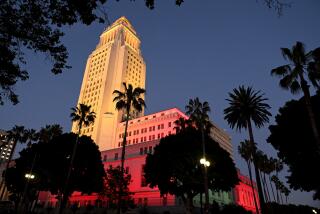Council Takes New Stand on Sports Arena : Development: In a turnaround, North City, not downtown, becomes leading contender for the facility envisioned by millionaire Harry Cooper.
In a sharp change of direction, the San Diego City Council on Monday turned its attention from aspirations for a downtown sports arena and authorized La Jolla millionaire Harry Cooper to explore locating his proposed “sports palace” on land he owns in Sorrento Hills.
Though they set in motion only a series of studies, the council made North City the current leading contender for the sports arena that Cooper hopes will lure National Hockey League or National Basketball Assn. teams.
Councilman Bruce Henderson, who proposed the policy change less than five months after the council had backed a downtown sports arena, called the vote a commitment to “seriously examine, as first choice, the North City site.”
Henderson was joined by council members Abbe Wolfsheimer, Wes Pratt, Linda Bernhardt, Judy McCarty and Bob Filner. Councilman Ron Roberts dissented and Mayor Maureen O’Connor and Councilman John Hartley were absent.
The vote came a week after City Manager John Lockwood’s office concluded that a new indoor arena downtown is “financially infeasible” without at least $26.5 million in public subsidies.
In contrast, Cooper says he can build a North City sports arena without a dime of public financing because he owns the 38-acre, Sorrento Hills property that could accommodate the six-acre arena and parking for 3,350 cars. Acquiring land downtown for the arena and a parking garage, and building the garage, would add more than $77 million to the $99.3-million
cost of a new arena.
Moreover, Cooper contends, a North City site would make the arena roughly equidistant to much of the South Bay, Escondido and north coastal suburbs, such as Carlsbad.
“We know that Sorrento Hills is an excellent site,” Cooper said. “It certainly takes into consideration people from Carlsbad and Escondido.”
Cooper, who made his fortune in the computer industry, purchased the lease to the city-owned Midway-area Sports Arena last June with hopes of redeveloping that property and erecting a new, 22,900-seat arena for professional team franchises on his Sorrento Hills land. He argued that the current 13,000-seat arena is too small to attract teams in an era of skyrocketing franchise costs.
But in November, the council ordered Cooper to focus his studies on an eight-block area of Centre City East.
The results of that analysis, conducted by city staff and private consultants, showed that revenue from the arena would leave the project $26.5 million to $71.2 million short of the $184.2 million needed for both the arena and the parking garage. The council, which only last month stalled another major downtown project--the new City Hall complex--because of cost concerns, and which is facing a sharp budget deficit for next year, balked at supplying the difference.
“Here we have a party coming forward (saying), ‘And we won’t cost you a dime,’ ” Henderson said of Cooper’s Sorrento Hills plan.
Roberts, long an advocate for downtown redevelopment, strongly opposed both the change of plans and the financial analysis that initiated it. He said that calculations of the value of a redeveloped sports arena property were grossly underestimated and he chided the council for its unwillingness to adopt special fees or excise taxes to construct a downtown arena.
“This report is loaded with suggestions on how you could solve this problem if you really want to put (the arena) downtown,” he said.
“NBA franchises come and NBA franchises go, but those arenas don’t move. And if you put the arena in the wrong place, you pay the penalty,” he said.
While the council agreed to further study some of Roberts’ concerns, and made clear that a new study would not necessarily preclude future attempts to build a downtown arena, Cooper expressed confidence that economic, environmental, traffic and other studies would prove that his site is preferable. He said consultants have conducted much of the analysis at a cost of about $250,000 and that additional study will add $100,000 to the tab.
He said that arena is dependent on California Department of Transportation plans to widen Interstate 5 to 14 lanes and build an interchange at Carmel Mountain Road, plans that themselves rely on voter approval of bond money for highway projects. Metropolitan Transit Development Board proposals to run a trolley line to the area by 1998 would also be a boon, he said.
Although Cooper has in the past talked to the NBA’s Seattle Supersonics and New Jersey Nets and the NHL’s Minnesota North Stars, he said he would not renew attempts to bring a franchise here until the arena site is selected. He said he hopes to have the arena open by 1995, but a team could play in the current Sports Arena while it is under construction.
Under the proposal approved Monday, a council committee will review the scope of the consultant studies May 9 before the council gives approval for the study to proceed.
Staff Writer G. Jeanette Avent contributed to this article.
More to Read
Go beyond the scoreboard
Get the latest on L.A.'s teams in the daily Sports Report newsletter.
You may occasionally receive promotional content from the Los Angeles Times.









